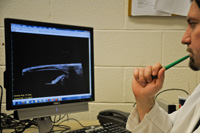Newly developed early canine glaucoma tests should help owners of breeding dogs
03-02-10

Dr. Helga Kecova, a research scientist in Dr. Grozdanic's lab, performs a High-Frequency Ultrasound procedure to screen for glaucoma.
Contacts:
Sinisa Grozdanic, College of Veterinary Medicine, Veterinary Clinical
Sciences, (515) 294-4389, sgrozdan@iastate.edu
Dan Kuester, News Service, (515) 294-0704,
kuester@iastate.edu
Newly developed early canine glaucoma tests should help owners of breeding dogs
AMES, Iowa - Researchers at Iowa State University have developed two new methods to detect glaucoma in dogs at an early age, long before the dogs show any signs of the disease.
The early detection should allow dog owners to make better breeding decisions and allow for earlier treatment of the disease.
Dr. Sinisa Grozdanic, assistant professor of veterinary clinical sciences at Iowa State's College of Veterinary Medicine, developed both novel High-Frequency Ultrasound (HFU) and Pattern Electroretinography (pERG) testing routines that allow for early diagnosis of glaucoma in dogs.
Both tests can be performed during normal clinic visits without injuring the dogs.
The HFU test allows doctors to look inside the eye, much like an X-ray.
 Grozdanic and Kecova examine HFU images created by the new
procedure.
Grozdanic and Kecova examine HFU images created by the new
procedure.
While examining HFU images from dogs with glaucoma, Grozdanic noticed that drainage tracts that normally drain fluid from the eye are collapsing in dogs with hereditary glaucoma.
Fluid in eyeballs constantly circulates as fresh fluid enters and older fluid is drained. The eyeball has a normal intra-ocular pressure (IOP) of 15 to 20 mm of mercury.
In dogs with the most common type of glaucoma, drainage tracts collapse and don't allow fluid to drain. As a result, IOP can reach 30 to 35 mm of mercury, or even higher, according to Grozdanic.
This can cause the eye to be "overinflated" which starts to destroy vision processing cells in the eye and can ultimately lead to blindness.
Grozdanic then looked at dogs that he suspected would get the disease, but had shown no signs of onset.
"One of the things we found using HFU is that these dogs' drainage tracts will start to collapse months or even years before any change in IOP occurs," said Grozdanic.
"Dogs usually develop glaucoma by the time they are 6 years old," he added. "By that age, they may have had three or four litters, if they are breeding dogs."
The litters born before the parents show signs of glaucoma will likely inherit the possibility of getting the disease.
The other test developed by Grozdanic, the pERG test, examines whether or not the optic nerve that carries visual information from the eye to the brain is functioning correctly as the IOP increases.
"We always considered that optic nerve function starts to decline as intraocular pressure starts to rise," said Grozdanic. "But it seems the optic nerve function starts to decline much earlier that we thought in dogs with hereditary predisposition to develop glaucoma."
 Grozdanic says certian breeds are more susceptible than
others.
Grozdanic says certian breeds are more susceptible than
others.
This test can also be done in the years before a dog shows the symptoms of glaucoma.
Both tests are designed to recognize the glaucoma before the dogs are bred.
Grozdanic's research is published in the journal Investigative Ophthalmology and Visual Science.
Several different dog breeds seem to be more susceptible to glaucoma than others, according to Grozdanic.
"In some breeds (glaucoma) is very prevalent," he said. "Bassets, American cocker spaniels -- there are about 50 breeds that regularly get hereditary glaucoma.
"Obviously if you have a breed that is considered high risk, it is probably a good idea to have the glaucoma screening done at some time as a part of general wellness examination.
"And especially for breeding dogs. You really want to be sure for a breeding dog, that after you put all the work and effort into it, then it does not transmit the disease to the offspring. Well, glaucoma doesn't make happy owners, breeders or buyers," he said.
Dogs that are not for breeding can be helped by the screening also.
If owners get their dogs screened early, Grozdanic says, they can start treatment early and delay the symptoms from the normal age of 5 or 6 -- when the symptoms become obvious -- to the age of 9 or 10.
Treatments, including eye drops, pills or surgery, will delay the onset of the disease, but they will not prevent it, he said.
Currently, Iowa State University is the only clinic that offers both types of screening in dogs, according to Grozdanic.
Grozdanic's research is supported by the Iowa State
biotechnology funds and the Basset Hound Club of America.
-30-